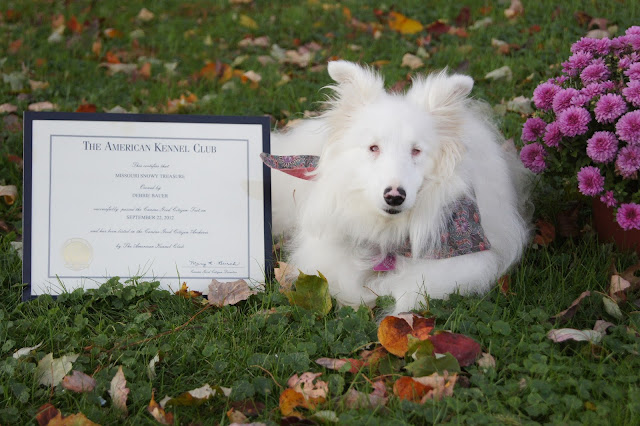Your dog can learn to stay in different positions. Most dogs prefer to stay in the down position. It is most comfortable for the dog to stay in for a length of time. It also takes the most effort for the dog to move from a down position, as opposed to a sit or a stand stay. If you expect to teach the stay in different positions, however, you may want to teach the sit stay before the down stay. Dogs taught to down stay first, may often try to lie down while left on a sit stay because that is their habit already.
Stay
can be a difficult exercise for your b/d dog to learn. All dogs like to be with us and don’t
necessarily like to be left behind while we walk away. But b/d dogs really like to keep track of us
and they won’t be able to track us with their eyes as we leave to know where we
are.
Begin
teaching stay by standing right next to your dog. Don’t be in a hurry to walk away. When you are practicing sit and down
positions, reward while your dog is in position but don’t release her. Instead, quickly reward again with her still
in position. By rewarding several times
without a release cue, you are getting your dog used to staying in position
longer. After feeding several treats,
then give the release cue.
Gradually
pause slightly longer between treats, so your dog learns to wait in position
longer for the treats. When you are sure
your dog will wait in position for the next reward to come, you can begin to
add the stay cue. If she is still trying
to move out of position before the release cue, you need to practice this step
more before moving on.
Ask
your dog to sit. Reward in
position. Then give the stay cue and
immediately reward your dog while she is still in the sit position. Then release.
She just did her first very short sit stay! The goal will be to very gradually build up
the amount of time between the stay cue and the reward. If your dog gets up after the stay cue but
before the reward, begin again without rewarding. The next time, make the time between the stay
cue and the reward shorter so she can be successful.
Build
up to a 20 second stay with you staying right next to your dog. Make sure you aren’t touching her during that
time, because as you start to walk away from her, you won’t be able to touch
her. You don’t want her relying on
touching you to stay in place. Make your
stay cue very clear, and make your release cue very clear. Any rewards should come while your dog is
still in the stay position. If your dog
lays down during the stay and you wanted her to sit, give the release cue and
let her get up so you can start over again.
Do not reward, but make the next sit stay shorter so you can reward
while she is still sitting.
When
your dog can do a 20 second stay with you next to her, you can take one small
step away from her after you give the stay cue.
Immediately step back next to her and reward. Each time you practice, vary the direction
you step away from her. One time go out
to the side, one time to the front, one time backwards. When this is going well, take two steps away
and immediately come back. Then take two
steps away and build up the time again to 20 seconds gradually. It’s better to come back quickly and be able
to reward a successful stay than to try to stretch the time too far and cause
your dog to make a mistake.
Gradually
add more distance and more time. When
you go farther, cut down the time at first and then build back up. When you want to add more time, stay close by
at first.







